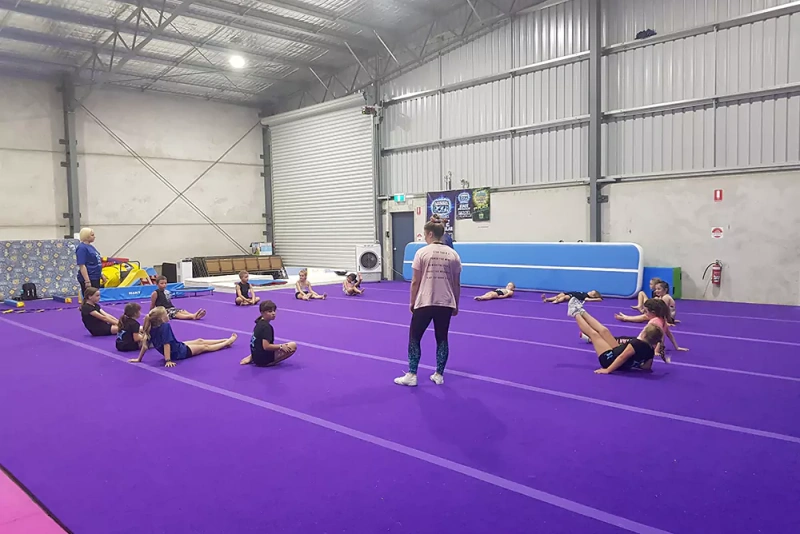Back Safety and Risks of Early Back Walkovers in Athletes Under 8
Back walkovers are a captivating skill in gymnastics and cheerleading, showcasing flexibility and strength. For athletes under 8 years old, performing these skills before their bodies are ready can pose risks to their spinal health, particularly with overuse of back-bending movements. This article is not designed to scare you away from tumbling or back walkovers but to raise awareness about the risks of excessive lower back bending in young athletes and provide strategies to ensure safe training.
The Demands of Back Walkovers
A back walkover involves starting from a standing position, arching backward into a bridge, and kicking over to return to standing. This movement requires core strength, shoulder and back flexibility, and balance, placing significant stress on the spine, especially the lumbar region, due to hyperextension. For athletes under 8, whose bones, muscles, and connective tissues are in early developmental stages, overuse of lower back bending in skills like back walkovers can lead to serious issues if not managed carefully.
Detailed Risks of Overuse in Back Walkovers for Athletes Under 8
Athletes under 8 have immature skeletal and muscular systems, making their spines particularly susceptible to injury from repetitive or excessive lower back bending. While tumbling is a rewarding activity, overuse of back walkovers without adequate strength, flexibility, or technique can lead to several risks. Below is a detailed exploration of these dangers:
-
Lower Back Pain and Muscle Strains
Repetitive hyperextension of the lower back during back walkovers can strain the muscles, tendons, and ligaments in children under 8, whose soft tissues are less resilient. Overuse can cause microtears, leading to acute or chronic pain that worsens with repeated back-bending. Young athletes may not report discomfort due to enthusiasm or lack of awareness, delaying intervention. Persistent strains can create muscle imbalances, further destabilizing the spine. -
Spondylolysis and Stress Fractures
Spondylolysis, a stress fracture in the pars interarticularis of the vertebra, is common in sports with repetitive back extension. The developing vertebrae of athletes under 8 are softer and more prone to stress fractures from overuse of lower back bending in back walkovers. Symptoms include localized pain that intensifies during hyperextension and may radiate to the buttocks. If untreated, spondylolysis can progress to spondylolisthesis, where the vertebra slips forward, potentially causing nerve compression and long-term issues. Young gymnasts are at higher risk due to frequent back-bending skills. -
Overuse Injuries
Athletes under 8 often train intensively, repeating back walkovers multiple times per session. Overuse of lower back bending without sufficient core strength, flexibility, or rest can lead to chronic inflammation, microtrauma to the vertebrae, or soft tissue fatigue. The growth plates in the spine of young children are particularly vulnerable to repetitive stress, which can disrupt bone development and lead to persistent soreness or stiffness that worsens with activity. -
Long-Term Spinal Damage
The spine of a child under 8 is still forming, with growth plates critical for proper bone growth and alignment. Excessive lower back bending from overuse of back walkovers can damage these growth plates, potentially causing abnormal spinal curvature, such as increased lumbar lordosis. This may lead to chronic back pain, reduced mobility, or degenerative conditions like disc herniation later in life. Improper technique, such as over-relying on lumbar extension, exacerbates these risks. -
Shoulder and Back Flexibility Imbalance
Back walkovers require balanced flexibility in the shoulders and lower back. In athletes under 8, underdeveloped shoulder flexibility often leads to overcompensation through excessive lower back bending, increasing stress on the lumbar spine. This imbalance heightens the risk of strains, stress fractures, and chronic pain, particularly with overuse. Without targeted flexibility training, poor movement mechanics can further predispose young athletes to injury. -
Growth Plate Vulnerability
The growth plates in the spine of children under 8 are weaker than surrounding tissues, making them prone to damage from repetitive lower back bending. Overuse during back walkovers can cause acute injuries or chronic stress to these areas, potentially leading to growth disturbances, uneven vertebral development, or spinal deformities. This risk is heightened during rapid growth periods before age 8. -
Neurological Risks
In rare but severe cases, excessive lower back bending from overuse can lead to neurological complications. For example, spondylolisthesis or severe lumbar strain may compress spinal nerves, causing tingling, numbness, or weakness in the legs. These complications are particularly concerning in athletes under 8, as they can impact long-term motor function if not addressed promptly.
Strategies for Safe Skill Progression in Athletes Under 8
Tumbling and back walkovers can be safe and enjoyable with proper precautions. To minimize risks from overuse of lower back bending, coaches and parents can adopt these evidence-based strategies for athletes under 8:
-
Drills and Conditioning: Introduce drills to gradually build strength and flexibility. Wall-supported handstands strengthen the upper body for the bridge position, while gentle, supervised stretching enhances shoulder and back flexibility, reducing reliance on lower back bending.
-
Limited Attempts Rule: Use a “rule of three” to prevent overuse injuries. If an athlete under 8 cannot perform a back walkover correctly after three attempts, they should return to foundational drills, reducing repetitive stress on the lower back.
-
Mental and Physical Safety: Address psychological barriers, as fear can lead to improper technique and excessive back bending. Drills like backward walks against a wall build confidence in backward movements while promoting safe form.
-
Injury Prevention Education: Coaches must understand the vulnerabilities of athletes under 8, particularly the risks of overusing lower back bending. Age-appropriate conditioning programs are crucial to prevent acute and overuse injuries.
Practical Tips for Safe Training
To protect the backs of athletes under 8 while training for back walkovers, consider these practical steps to avoid overuse of lower back bending:
-
Build Strength and Flexibility Gradually: Develop a strong core, adequate shoulder flexibility, and controlled lower back flexibility before attempting back walkovers. Drills like bridge kickovers on a mat or wall walkovers reduce lower back stress while building skills.
-
Use Proper Technique: Emphasize correct form, such as pushing shoulders forward in the bridge position to distribute load and minimize lumbar hyperextension. Spotters are essential for guiding proper alignment in young children.
-
Limit Repetitions: Strictly limit back walkover repetitions to prevent overuse injuries. The rule of three balances practice with safety, reducing strain on the lower back.
-
Incorporate Rest and Recovery: Schedule rest between sessions to allow spinal tissues to recover. For signs of back pain, use rest, ice, compression, and elevation (RICE), and seek medical evaluation if pain persists.
-
Monitor for Pain: Vigilantly monitor athletes under 8 for lower back pain, especially during or after back walkovers. Persistent pain lasting more than a few days requires a medical evaluation, including imaging to rule out stress fractures or growth plate injuries.
-
Work with Certified Coaches: Ensure coaches are trained in age-appropriate techniques, CPR, and first aid. They must prioritize safety and understand the risks of excessive lower back bending in athletes under 8.
Conclusion
Back walkovers are a rewarding part of tumbling, but overuse of lower back bending in athletes under 8 can lead to significant spinal health risks, including pain, stress fractures, and long-term damage. This article is not meant to discourage participation in gymnastics or cheerleading but to highlight the importance of awareness and caution. By prioritizing gradual strength and flexibility development, proper technique, and vigilant injury prevention, coaches can help young athletes safely master back walkovers. Careful training ensures that children under 8 can enjoy their sport while protecting their developing spines for the future.


